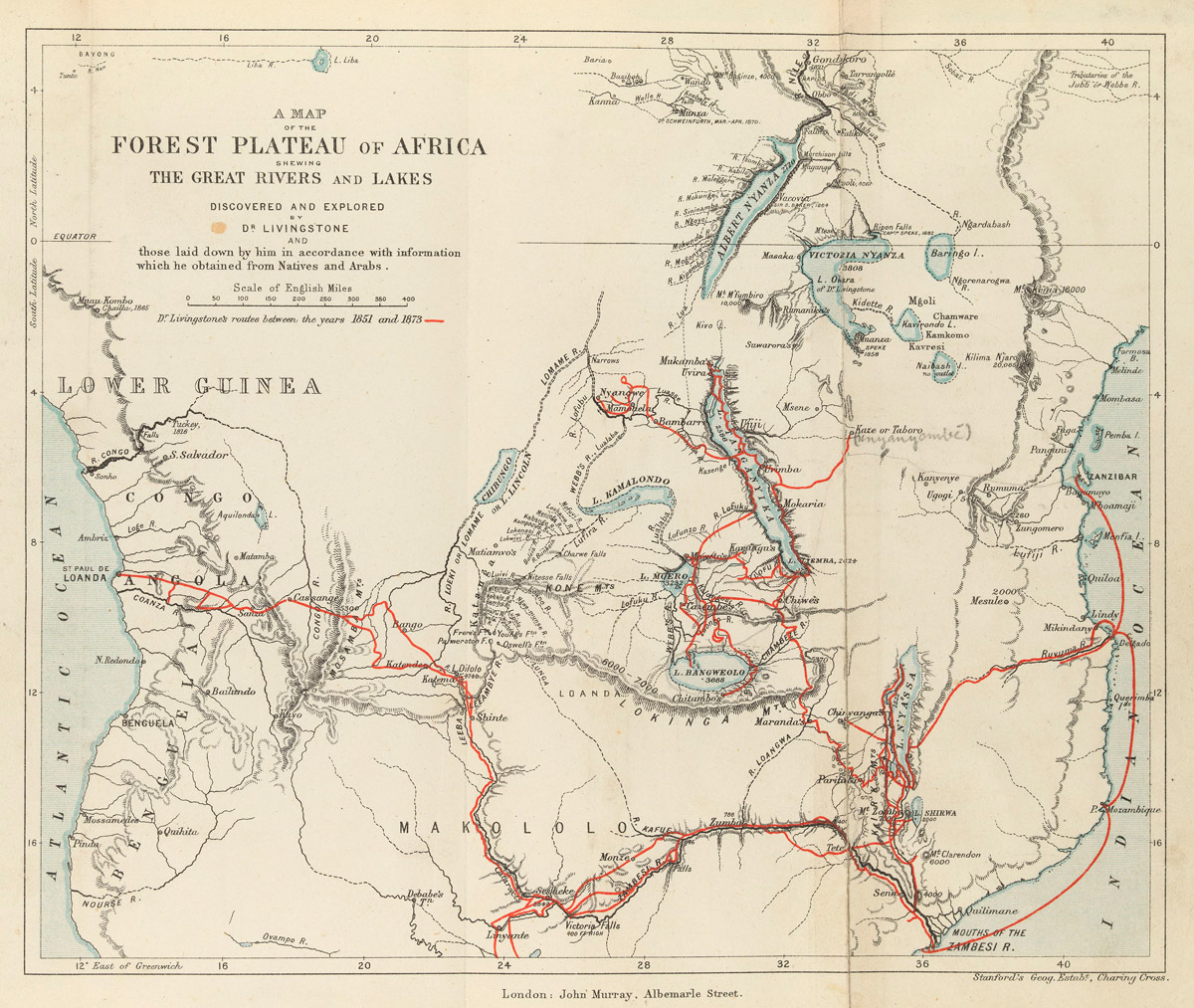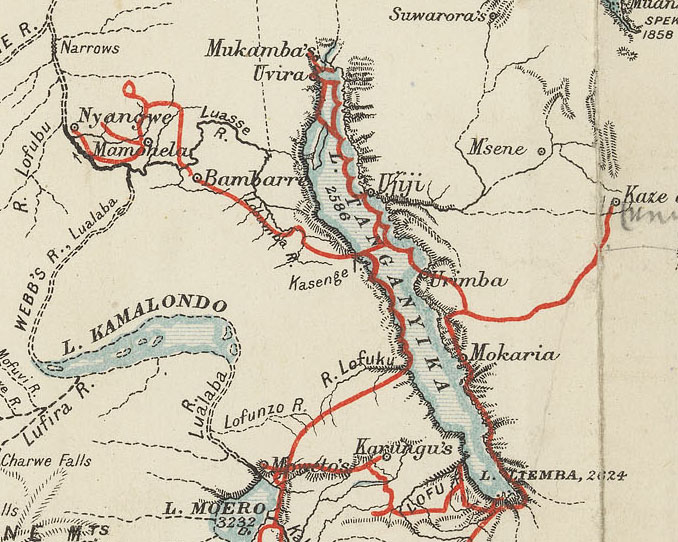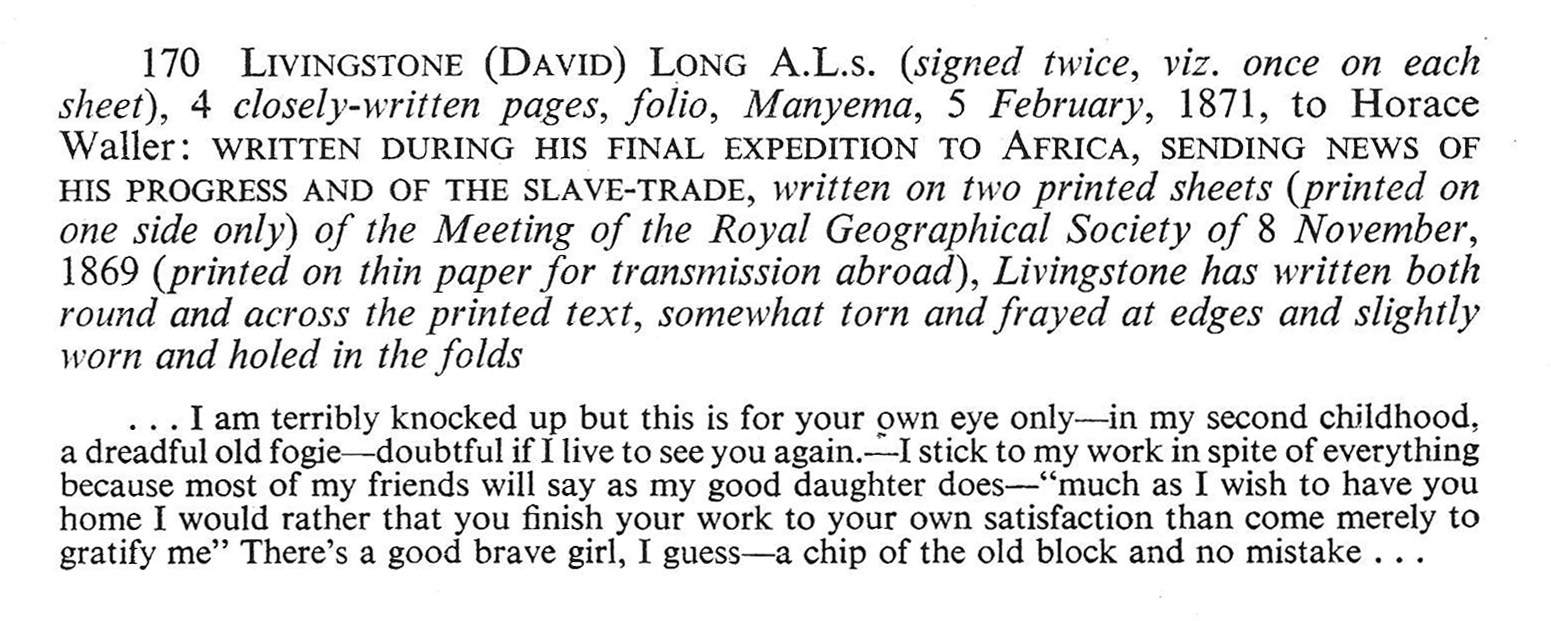Background of the Edition
Cite page (MLA): Wisnicki, Adrian S. "Background of the Edition." In Livingstone's Letter from Bambarre. Adrian S. Wisnicki, dir. Livingstone Online. Adrian S. Wisnicki and Megan Ward, dirs. University of Maryland Libraries, 2017. Web. http://livingstoneonline.org/uuid/node/72224f6c-477c-4e88-9a84-a625a61d4681.
This page details the history of the Letter from Bambarre. The page begins by outlining the circumstances that led Livingstone to compose the letter, then describes the subsequent history of the letter, particularly after its purchase at a Sotheby's auction in 1966 by Peter Beard.
Livingstone was at a personal and profession nadir when he wrote his letter to Waller. The dramatic crossing of the African continent from 1852 to 1856 and the resulting narrative, Missionary Travels (1857), established Livingstone's reputation as an explorer, abolitionist, and imperial visionary. Unfortunately, his subsequent journey to Africa (1858-64) revealed that many of his plans for African colonization and development had been poorly conceived.

The small foldout map of central Africa included with the published edition of Livingstone's Last Journals (1874). Copyright National Library of Scotland. Creative Commons Share-alike 2.5 UK: Scotland. Bambarre lies almost exactly at the center of the map, just west of Lake Tanganyika (see section detail, below). The lines in red trace Livingstone's three journeys around and across Africa.
The last journey, which began in March 1866, offered a chance to alter the trajectory of Livingstone’s career and restore his reputation. He sought to examine the watershed of central Africa, promote the introduction of commerce into the region, and, ultimately, locate the most southern source of the Nile, the grand geographical prize of the nineteenth century.
However, after three unsuccessful years exploring the lakes and rivers to the south of Lake Tanganyika, Livingstone realized that he would have to examine a river that ran to the west of the lake, the Lualaba, in order to determine the river’s connection – if any – to the Nile. In March 1869 Livingstone reached Ujiji, an Arab trading depot on the eastern shore of Lake Tanganyika. By the end of July 1869 he had crossed the lake and was heading west, intent on rapidly passing through the region of Manyema in order to strike the Lualaba "roughly three hundred miles west of Ujiji" (Jeal 1973:326). He planned to finish exploring the river in six months then return to Ujiji.

The small foldout map of central Africa included with the published edition of Livingstone's Last Journals (1874), detail. Copyright National Library of Scotland. Creative Commons Share-alike 2.5 UK: Scotland. Bambarre lies just left of the center of the image.
After a year of travel, however, he had managed to get only as far as Bambarre, a village 150 miles west of Lake Tanganyika. Deserted by all but three followers and severely depressed, he had been delayed by pneumonia, fever, dysentery, heavy anal bleeding, and "irritable ulcers on the feet" (Livingstone 1870e:X; Jeal 1973:326-31).
Yet on 4 February 1871, Livingstone gained new hope. Ten men sent by John Kirk, acting Consul and Political Resident at Zanzibar, arrived in Bambarre bringing supplies and letters – including three from Waller – with the first news of Europe that Livingstone had had for several years. The next day, 5 February 1871, Livingstone began writing his letter to Waller.

The two pages of the Letter from Bambarre side by side prior to conservation. Copyright Adrian S. Wisnicki. Creative Commons Attribution-NonCommercial 3.0 Unported
In the twentieth century, the letter surfaced at a Sotheby’s auction in London (Catalogue 1966:44), where it was purchased by Peter Beard, the American photographer. Beard, equally renowned for his photos of celebrities and Africa and African wildlife, was immediately taken with the letter and has remained so to the present day. In late 1966 or early 1967, he transported the letter to "Hog Ranch," his property in Kenya, which lies adjacent to the farm of Karen Blixen, author of Out of Africa.

The entry (lot 170) from Sotheby's Catalogue (28 Nov. 1866) for the Letter from Bambarre. Bidding for the letter began at £110 ($308).
Beard kept the letter there until 1991, when a termite infestation, which had already damaged some first edition Africana books, compelled him and his wife Nejma to take the letter to their home in Manhattan. "I carried the letter to New York from Kenya," writes Nejma Beard of transporting the framed letter. "I took it through London, with my baby daughter Zara under one arm and the letter under the other! It was heavy I can tell you" (private communication to A. Wisnicki).
In late 2009, just as the diary project was being developed, the Beards contacted Livingstone Online through an intermediary, Elizabeth Upper, and offered to make the letter available for scholarly study. Planning for the critical edition began there and then.
* For more on the composition of the letter, see Note on the Text of the Letter.
* For more on the subsequent nineteenth-century history of the letter, see The Letter with Annotations, note for 0001.1.



![Processed spectral image of a page from Livingstone's 1871 Field Diary (Livingstone 1871k:[5] pseudo_v1), detail. Copyright David Livingstone Centre and Dr. Neil Imray Livingstone Wilson: CC BY-NC 3.0 Processed spectral image of a page from Livingstone's 1871 Field Diary (Livingstone 1871k:[5] pseudo_v1), detail. Copyright David Livingstone Centre and Dr. Neil Imray Livingstone Wilson: CC BY-NC 3.0](https://livingstoneonline.org:443/sites/default/files/section_page/carousel_images/liv_013723_0001-new-carousel_0.jpg)



![Processed spectral image of a page from David Livingstone's "Retrospect to be Inserted in the Journal" (Livingstone 1870a:[3] pseudo_v4_BY), detail. Copyright National Library of Scotland and Dr. Neil Imray Livingstone Wilson: CC BY-NC 3.0 Processed spectral image of a page from David Livingstone's "Retrospect to be Inserted in the Journal" (Livingstone 1870a:[3] pseudo_v4_BY), detail. Copyright National Library of Scotland and Dr. Neil Imray Livingstone Wilson: CC BY-NC 3.0](https://livingstoneonline.org:443/sites/default/files/section_page/carousel_images/liv_000211_0003_pseudoBY_940_by_592-carousel.jpg)

![David Livingstone, Map of Central African Lakes, [1869], detail. Copyright National Library of Scotland: CC BY-NC-SA 2.5 SCOTLAND and Dr. Neil Imray Livingstone Wilson: CC BY-NC 3.0 David Livingstone, Map of Central African Lakes, [1869], detail. Copyright National Library of Scotland: CC BY-NC-SA 2.5 SCOTLAND and Dr. Neil Imray Livingstone Wilson: CC BY-NC 3.0](https://livingstoneonline.org:443/sites/default/files/section_page/carousel_images/liv_003006_0001-new-carousel_0.jpg)